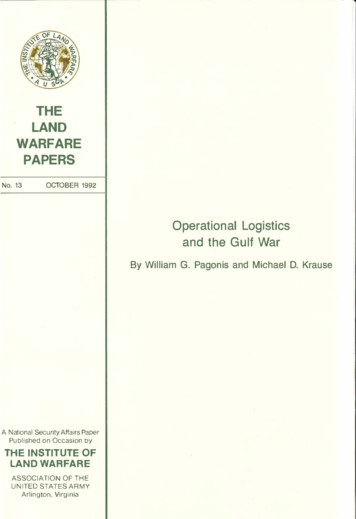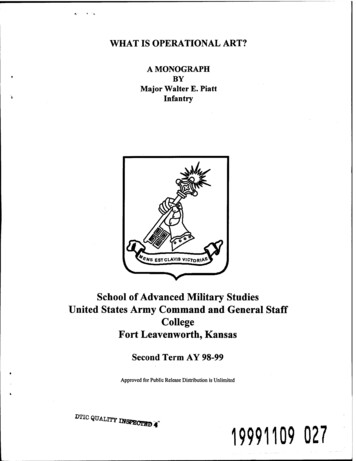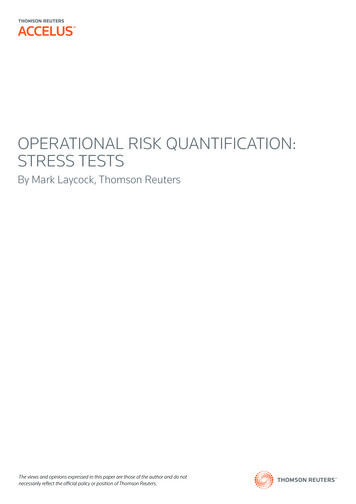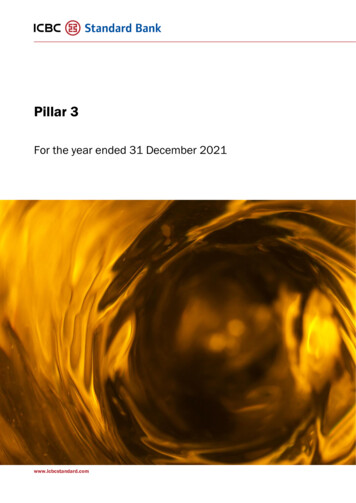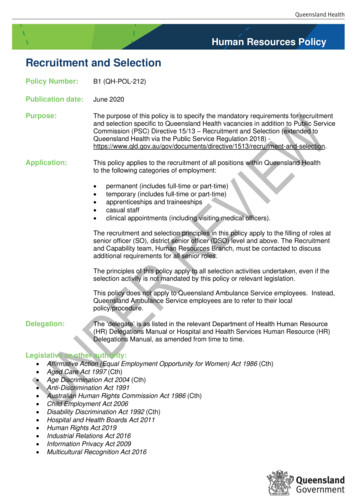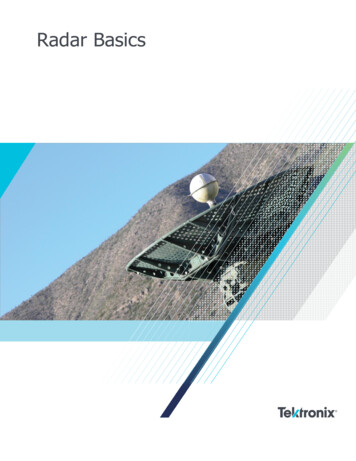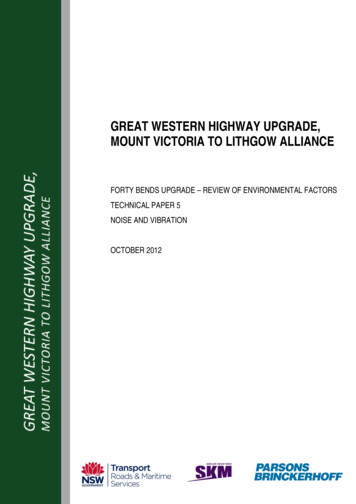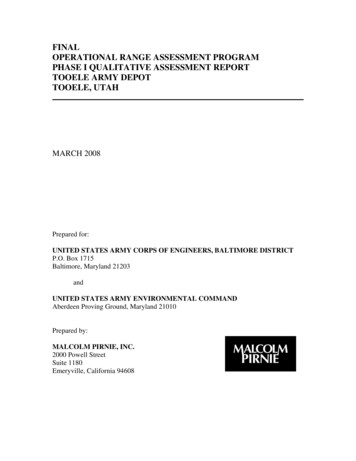
Transcription
FINALOPERATIONAL RANGE ASSESSMENT PROGRAMPHASE I QUALITATIVE ASSESSMENT REPORTTOOELE ARMY DEPOTTOOELE, UTAHMARCH 2008Prepared for:UNITED STATES ARMY CORPS OF ENGINEERS, BALTIMORE DISTRICTP.O. Box 1715Baltimore, Maryland 21203andUNITED STATES ARMY ENVIRONMENTAL COMMANDAberdeen Proving Ground, Maryland 21010Prepared by:MALCOLM PIRNIE, INC.2000 Powell StreetSuite 1180Emeryville, California 94608
Operational Range Assessment Program, Phase I Qualitative Assessment ReportTooele Army Depot, UtahFebruary 2007EXECUTIVE SUMMARYPURPOSE:This qualitative assessment, hereinafter referred to as Phase I Assessment, evaluates Tooele ArmyDepot’s (TEAD’s) operational range area to assess whether further investigation is needed todetermine if potential munitions constituents of concern (MCOC) are or could be migrating off-rangeat levels that may pose an unacceptable risk to human health or the environment. The Phase IAssessment results in the categorization of operational ranges as appropriate, as follows: Referred – Refer to Appropriate Cleanup Program: ranges with compelling evidence(e.g., sampling data) to indicate the presence of an off-range release that potentially posesan unacceptable risk to human health or the environment; Inconclusive – Phase II Quantitative Assessment Required: ranges where existinginformation either is insufficient to make a source-receptor interaction determination orindicates the potential for such interaction to be occurring; or Unlikely – Five-Year Review : ranges where, based upon a review of readily availableinformation, there is sufficient evidence to show that there are no known releases orsource-receptor interactions that could present an unacceptable risk to human health orthe environment.1SUMMARY OF FINDINGS:To facilitate the qualitative analysis, MCOC sources, potential migration pathways from a range, andpotential off-range human and/or ecological receptors associated with the ranges at TEAD wereevaluated. Each range was then placed into one of several descriptive groups that meet the criteria forthe Unlikely category.The four operational ranges at TEAD that were included in the Phase I Assessment have been placedinto the following category.Unlikely – Four ranges, totaling 576 acres, consisting of an actively used Small Arms Range andthree ranges that are not currently in use: a Small Arms Range and two munitions testing sites.These findings are summarized in Table ES-1.1All operational ranges must be periodically re-evaluated to determine if there is a release or substantial threatof release of MCOC from an operational range to an off-range area. Range groups categorized as Unlikely areto be re-evaluated at least every five years. Re-evaluation may occur sooner if significant changes (e.g.,changes in range operations, site conditions, regulatory changes) occur that affect determinations made duringthe Phase I Assessment.Malcolm Pirnie, Inc.ES - 1
Operational Range Assessment Program, Phase I Qualitative Assessment ReportTooele Army Depot, UtahFebruary 2007Table ES-1: Summary of Findings, Conclusions, and Recommendations for TEADTotal Numberof Ranges andAcreageSource(s)Pathway(s)Munitions used; surfacewater and groundwaterpathways not present2 operationalranges totaling23 acresFiring points,berms, craters,and impact areasNoneLimited source2 operationalranges totaling553 acresNo source –limited or nomilitarymunitions useCategory Group IdentificationUnlikelyMalcolm Pirnie, Inc.HumanReceptorsEcologicalReceptorsNot evaluated (no pathwayswere identified)Not evaluated (no source was identified)Conclusions andRationaleRe-evaluate during thefive-year review. Nopathways wereidentified.Re-evaluate during thefive-year review. Nosource was identified.ES - 2
Operational Range Assessment Program, Phase I Qualitative Assessment ReportTooele Army Depot, UtahFebruary 2007ABBREVIATIONS/ACRONYMS CCFSHMXLSMCMCOCMECmmMGWMGW (H/E)MPUMSWMSW (H/E)MSWGWMSWGW (H/E)MULTIMEDNPLOB/ODORAPORISPRGRCRARDXRIMalcolm Pirnie, Inc.Degrees FahrenheitMicrograms Per GramAbove Mean Sea LevelArmy Range Inventory GeodatabaseBelow Ground SurfaceBase Realignment and ClosureConceptual Site ModelDeseret Chemical DepotDinitrotolueneDepartment of DefenseDepartment of Defense InstructionDepartment of EnergyDirectorate of Plans, Training, Mobilization and SecurityEnvironmental Chemical CorporationFeasibility StudyCyclotetramethylenetetranitramineLimited or no munitions have been used on the range.Munitions ConstituentsMunitions Constituents of ConcernMunitions and Explosives of ConcernMillimetersMunitions have been used on the range. A groundwater migration pathwaywas identified, but no receptors have been identified.Munitions have been used on the range. The groundwater source-receptorinteraction is potentially complete (for human or ecological receptors).Munitions have been used on the range, but migration pathways areunlikely or incompleteMunitions have been used on the range. A surface water migration pathwaywas identified, but no receptors have been identified.Munitions have been used on the range. The surface water source-receptorinteraction is potentially complete (for human or ecological receptors).Munitions have been used on the range. Groundwater and surface watermigration pathways have been identified, but no receptors have beenidentified.Munitions have been used on the range. The surface water and groundwatersource-receptor interactions are potentially complete (for human orecological receptors).Multimedia Exposure Assessment ModelNational Priorities ListOpen Burn/Open DetonationOperational Range Assessment ProgramOperational Range Inventory SustainmentPreliminary Remedial GoalResource Conservation and Recovery ActCyclotrimethylenetrinitramineRemedial Investigationiii
Operational Range Assessment Program, Phase I Qualitative Assessment ReportTooele Army Depot, PMU.S.C.USEPAUTMalcolm Pirnie, Inc.February 2007Solid Waste Management UnitTooele Army DepotTooele Army Depot – North AreaTooele Army Depot – South AreaTooele Chemical ActivityTrinitrotolueneUtah Department of Environmental QualityUnited StatesUnited States Army Corps of EngineersUnited States Army Center for Health Promotion and Preventive MedicineUnited States CodeUnited States Environmental Protection AgencyUtahiv
Blue Lakes³ UV138GrantsvilleTOOELE ARMY tallationHydrologyInstallation BoundaryRiver/Stream (Perennial)Operational AreanCmackHiStream (Intermittent)Other than Operational AreaProgrammatic RCRA Exclusionankree\\Whi gis\GIS DATA\Projects\ARMY\Installations\Tooele Army Depot\ORAP\MXDs\Figure 1-1.mxdPineBox Elder CreekkreeSouthCllowWihtrNoUVHickmekC reWater BodyUrbanized AreaStocktonTransportationMajor RoadLocal RoadRush LakeRailroadSoldierCreekOperational Range Assessment ProgramPhase I Qualitative AssessmentTooele Army Depot, UTFigure 1-1Installation Location01MilesData Sources:AEC, ARID-GEO, 2005ESRI, StreetMap USA, 2005Date: . February 2007Prepared By: . Malcolm Pirnie, Inc.Prepared For: . U.S. ArmyContract: . W912DR-05-D-0004
OPERATIONAL RANGE ASSESSMENT PROGRAM PHASE I QUALITATIVE ASSESSMENT REPORT TOOELE ARMY DEPOT TOOELE, UTAH MARCH 2008 Prepared for: UNITED STATES ARMY CORPS OF ENGINEERS, BALTIMORE DISTRICT P.O. Box 1715 Baltimore, Maryland 21203 and UNITED STATES ARMY ENVIRONMENTAL COMMAND Aberdeen Proving Ground, Maryland 21010 Prepared by: MALCOLM PIRNIE, INC.

